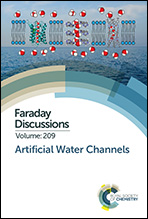Water permeation across artificial I-quartet membrane channels: from structure to disorder
Abstract
Artificial water channels (AWCs) have been designed for water transport across membranes with the aim to mimic the high water permeability observed for biological systems such as aquaporins (∼108–109 water molecules per s per channel), as well as their selectivity to reject ion permeation at the same time. Recent works on designed self-assembling alkylureido-ethylimidazole compounds forming imidazole-quartet channels (I-quartets), have shown both high water permeability and total ionic-rejection. I-quartets are thus promising candidates for further development of AWCs. However, the molecular mechanism of water permeation as well as I-quartet organization and stability in a membrane environment need to be fully understood to guide their optimal design. Here, we use a wide range of all-atom molecular dynamics (MD) simulations and their analysis to understand the structure/activity relationships of the I-quartet channels. Four different types with varying alkyl chain length or chirality have been studied in a complex fully hydrated lipid bilayer environment at both microsecond and nanosecond scale. Microsecond simulations show two distinct behaviors; (i) two out of four systems maintain chiral dipolar oriented water wires, but also undergo a strong reorganization of the crystal shape, (ii) the two other I-quartet channels completely lose the initial organization, nonetheless keeping a water transport activity. Short MD simulations with higher time resolution were conducted to characterize the dynamic properties of water molecules in these model channels and provided a detailed hypothesis on the molecular mechanism of water permeation. The ordered confined water was characterized with quantitative measures of hydrogen-bond life-time and single particle dynamics, showing variability among I-quartet channels. We will further discuss the underlying assumptions, currently based on self-aggregation simulations and crystal patches embedded in lipid bilayer simulations and attempt to describe possible alternative approaches to computationally capture the water permeation mechanism and the self-assembly process of these AWCs.

- This article is part of the themed collection: Artificial Water Channels


 Please wait while we load your content...
Please wait while we load your content...